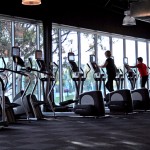If you’re really serious about taking off those last ten pounds or just improving the way you eat, use a calorie log. Daily calorie logs provide a source of personal accountability and act as a learning tool. Balancing calories IN and calories OUT will guide you to your goal.
 A calorie log should include what you consume, as well as how much you consume, and how often you consume it. And a really good log starts with what you planned to eat and then what actually passed your lips and took the dive. There are numerous online logs to choose from, but building a calorie-log of your own personalizes it and makes it work just for you.
A calorie log should include what you consume, as well as how much you consume, and how often you consume it. And a really good log starts with what you planned to eat and then what actually passed your lips and took the dive. There are numerous online logs to choose from, but building a calorie-log of your own personalizes it and makes it work just for you.
You can develop a short excel food log that takes no more than 15 minutes per day to fill out. Provide spaces to note the date, the time of day that you ate, and, of course, your daily totals. Develop your columns to allow space for food measurements and food descriptions, like poached pears, frozen edamame and fresh tuna. Your excel program has the capacity to total your calorie intake automatically which removes the responsibility from a mind and body on operation overload.
Include a column or block for logging calorie output which applies to cardio, strength-training and power walks. Estimate a calorie per minute for all cardio and adjust upward or downward for maximum or minimum level of exertion. Estimate half that for strength-training. Even though your heart rate and metabolism are elevated after cardio, strength-training immediately afterward doesn’t burn calories at the same rate as non-stop, heart-challenging cardio exercise. When you spend eight to 14 hours a day standing or leaning against your anesthesia chair and turning your head to follow a monitor, your eyes burn and your brain fries, but calories do not. You don’t get to subtract 1 calorie per minute for sitting.
Tweak your excel program to include issues unique to you. Do you want to know what percent of your calories were wasted? Relegate all non-fructose sugars, added fats, junk foods, non-nutrient beverages and excessive or unnecessary foods to the “wasted” column. Then divide wasted calories by gross calories to get the % of should-have-had-something else calories. Do you have GI issues? You may want to have a block on your log that represents how often you fully empty. There will be a relationship between what you eat, how much you eat and how well your GI system functions. How many meals did you eat at a restaurant or inhale on the fly? How many desserts did you consume? Do you drink enough water? Throw in a log block for number of glasses of unenhanced water you drink daily. Do you walk the stairs instead of taking elevators and do you do a lunchtime walk? I have clients who wear pedometers at work in order to track how active they are, a great way to remind yourself to use stairs, to go for 15-minute walks, and to lunge down hallways between patients…unless you’re working on kids, which will keep you running all day! Add a log block for calories burned during your normal daily activity, but don’t subtract it from your gross total. After all, most of our bodies were designed to get a leg up.
 It is generally accepted that 3500 calories equals a pound, lost or gained, so to lose a pound, you need to consume fewer calories than your body needs for function. Since you do not actually know how many calories you require, simply take in a few hundred less per day than you usually do. If you want to ditch 10 pounds, reduce your normal daily intake by a couple hundred. If you are morbidly obese – isn’t that a lovely admission of sin? – you will need to drop several hundred unnecessary calories per day, maybe a 1000. But, if you are seriously overweight, the bonus is the rapid, safe weight loss you will enjoy right up front. Thinner people will lose much more slowly, but they get to adjust their intake less dramatically, too. Beware of the RDA recommendations when planning your food day. It does not take 2000 calories to run a 5’4”-female body for 24 hours. In fact, it doesn’t take 2000 calories to maintain a 6’-male body that isn’t active. In further fact, if you eat a nutrient-dense, mostly plant-based diet, it is nearly impossible to consume 2000 calories per day without bloating into a state of flatulent, comatose exhaustion.
It is generally accepted that 3500 calories equals a pound, lost or gained, so to lose a pound, you need to consume fewer calories than your body needs for function. Since you do not actually know how many calories you require, simply take in a few hundred less per day than you usually do. If you want to ditch 10 pounds, reduce your normal daily intake by a couple hundred. If you are morbidly obese – isn’t that a lovely admission of sin? – you will need to drop several hundred unnecessary calories per day, maybe a 1000. But, if you are seriously overweight, the bonus is the rapid, safe weight loss you will enjoy right up front. Thinner people will lose much more slowly, but they get to adjust their intake less dramatically, too. Beware of the RDA recommendations when planning your food day. It does not take 2000 calories to run a 5’4”-female body for 24 hours. In fact, it doesn’t take 2000 calories to maintain a 6’-male body that isn’t active. In further fact, if you eat a nutrient-dense, mostly plant-based diet, it is nearly impossible to consume 2000 calories per day without bloating into a state of flatulent, comatose exhaustion.
At the end of each day, total your column of gross calories(food intake). Add your blocks of expended calories(cardio, strength training, strenuous sport activity). If you’re figuring percent of wasted calories, now’s the time. Then subtract output from intake for the total net calories. Your net should be noticeably less than your intake used to be, and your weekly reduction should be around 3500 to lose one pound. Eight to nine-hundred well-balanced calories is safe for most women and nine to eleven-hundred net works well for average men. Don’t forget: Fried chicken is not the same as grilled chicken breast; broccoli with cheese is not called fresh broccoli; ¼ cup of granola is not ¼ cup plus several-bites-while-measuring; and trail mix with fruit is not an apple. Be honest.
Using a food log gives you control over your daily nutrition plan and your weight loss. By writing down each and every item, you take charge of what you’ve planned and responsibility for what actually went down. The log will reveal to you what works and what doesn’t, when you’re really hungry and when you simply indulge. And it will also give you a sense of power over an issue that used to leave you feeling powerless. To get your power back AND lose ten pounds, count your calories because calories do count.
You can visit Liz online at www.bdyfrm.com where “…a fit body is a friend for life.”

